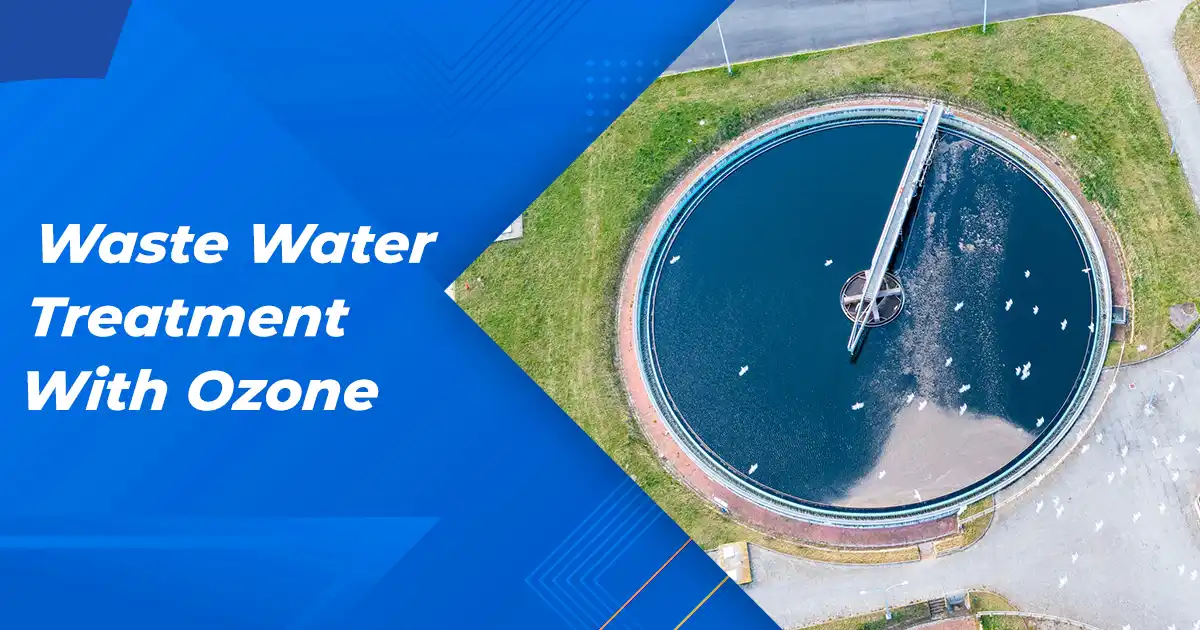Waste Water Treatment With Ozone
Posted on: December 9, 2022
How Advanced Ozonation Process is Changing Wastewater Treatment

Ozone Technology has been used for the past two decades or more. It is however only now that its use in waste water treatment/ effluent treatment has been recognized. However, the constant pressure by regulatory bodies to look for suitable technology to meet stringent norms have forced the industry to consider ozone. Today after drinking water, waste water has found the maximum number of ozone users in India.
Ozone Is A Powerful Oxidizing Agent
Ozone is a very powerful oxidizing agent, only next to OH radicals. How effective ozone is, will depend entirely on the nature of the contaminant and is directly dependent on the chemistry involved in the process. Many other oxidizing agents are often used in combination with ozone to provide increased efficacy. Agents such as peroxides, UV, and conditions of high pH assist ozone in the oxidation process.

Ozone in waste water and effluent treatment
Ozone finds use in each stage of waste water treatment. During the preliminary stage it is used for detoxification. At secondary stage it is used for sludge reduction, and during the tertiary stage it’s used for disinfection, micro pollutant removal, COD reduction and decoloration. The location of ozone is dependant on the goal of ozonation
In each of these cases the use of ozone has been found to be very productive.
- Decolorisation & Deodorization
- Detoxification
- Disinfection
- COD/BOD reduction
- Sludge Reduction

Decolorisation & Deodorisation
Due to new government restrictions for the discharge of colored water and the increasing discharge costs of waste water, ozone oxidation for decoloration is becoming more and more popular. The affected industries are companies producing textiles, dyes, paper or chemicals. In Addition to the very successful results in decoloration, ozone brings further benefits like disinfection, improved BOD/COD-ratio, reduced AOX and reduction of odour. Waste water or recycling water can be treated in an environmentally-friendly way without any residuals or concentrates by using ozone.
The design of decoloration systems with ozone depends mainly on the color causing compounds and on the COD background load in the water. Because of the chemical structure of colors the ozone reaction takes place within a few minutes whereas the reaction for the reduction of COD can take up to several hours. But nevertheless there is a close relationship between the ozone demand for decoloration and the COD concentration. Simply expressed, as higher the COD in the raw water, the higher the ozone demand will be.
If the raw water contains a high COD concentration a biological pretreatment is recommended prior to ozonation to reduce the COD to a level as low as possible. Based on this the ozone demand for decoloration can be reduced drastically
- Biological waste water treatment typically does not remove colorful substances sufficiently
- Reuse of colored wastewater is normally not possible (paper-, textile-, chemical-, dye- industry)
- Pollution of surface water by colored waste water is obvious so the source (WWTP) can be easily identified
- Local government restrictions are planned or in place to limit the discharge of colored waste water from industrial and municipal WWTP.
OZONE therefore is an ideal oxidation technology to remove color
Odor causing compounds that are organic in nature are easily destroyed by ozone. It is for these reasons that ozone finds immense use in municipal drinking water plants and also in chemical industries discharging effluents that contain odorous compounds such as H2S etc.
Detoxification :
Some of the more common toxic substances that are found in waste water (Industrial and Municipal too) are:
- Chemicals like cyanide, phenols and phenolic compounds,nitrites
- Pesticides and products such as tensides (surfactants in detergents)
- Micro pollutants such as EDC (Endocrine disrupting Compounds )
We are quite aware of toxic substances such as pesticides, phenolic compounds that have been addressed by pollution Control authorities in India .However the world has woken up to a new set of compounds known as EDC (Endocrine disruptive compounds).
EDCs are micro pollutants.
- Different groups of persistent micro pollutants are daily released by human activities into the water cycle.
- EDC´s (Endocrine Disrupting Compounds), pharmaceuticals and personal care products are groups of emerging contaminants.
- EDC´s are substances which impact hormone function in animals and humans.
- Natural or man made that disrupt growth, development, or reproduction.
- Anthropogenic substances that affect the hormone balance.
- A cause for great concern is the Multiplier effect.
- Growing concern forced detailed Investigations into this topic all over the world (Australia, Switzerland, UK, USA,..).
Pharmaceuticals in Water: This is of very great concern all over the world. Iodinated Contrast agents such as Iopromide, Iomeprol Diatrizoate have been found in waste water in concentrations as high as 4.5 to 5 micrograms per ml of waste water. Other presence of antibiotics, beta blockers and anti epileptics have been found in concentrations of 1-1.5 micrograms per ml.
Some of the discussed treatments concepts for these micropollutants are:
- Improve the existing biological system.
- Evaluation of the best additional treatment step (depending on the water source, contaminant and treatment goal) such as
- a. Activated Carbon
- b. Oxidation Process (Ozone(UV/H2O2)
- c. Membranes (Nano, RO)
- d. Process combination of different steps
Independent studies identified ozone treatment as most effective in terms of elimination rate and treatments costs
It has been found that:
- Ozone treatment achieves removal rates > 90% for most investigated compounds
- Ozone reduces the over all estrogenicity
- Relatively low doses (3 to 10 mg/L) ensure selective oxidation of contaminants
- Ozone reactions are more selective and predictable in waste water than radical reactions
- Ozone is best available technology for EDC treatment
- Ozone technology is available and reliable in large scale – practical experiences and references exist
These can be responsible for causing several water borne diseases.
The Main advantages of Ozone for waste water disinfection include
- Compliance with WHO or even California title 22 that is possible with ozone
- A small dosage of 5 g O3/m3 waste water achieves at least a 2-log reduction of coli forms, and a dosage of 15 g O3/m3 upto 3-log reduction including parasite removal
No production of harmful by products seen with ozone - Parallel removal of unpleasant odors has been a bonus with ozone
- Parallelly there is an extensive elimination of persistent Micro pollutants
- Removal of colored substances not possible with UV technology
- Growing increase of acceptance for water re-users
COD/BOD Reduction:
The table below gives some idea of the choice of different technologies available for waste water treatment. Mostly the Choice of a particular technology is governed by two criteria:
- The flow of the effluent
- The COD content
| TECHNOLOGY | COD CONTENT mg/l | FLOW RATE |
| INCINERATION AND EVAPORATION | 15000 – 100000 | 1M3 /hr to 10M3/hr |
| ANAEROBIC BIOLOGICAL TREATMENT | 15000 – 100000 | 10M3/hr to 100M3.hr |
| WET AIR OXIDATION | 8000-50000 | 5M3/hr to 100M3/hr |
| AOP ( UV /H2O2/FENTON ) | 1000-6000 | 0.5M3/HR TO 10M3/HR |
| AEROBIC BIOLOGICAL TREATMENT INCLUDING ACTIVATED SLUDGE/MBR/BIO FILTER | 15 – 10000 | 10M3/HR-10000 M3/HR |
| OZONE | 10 – 1200 | 1M3/HR TO 10000M3/HR |
| ELECTROLYTIC OZONE INCLUDING LBT UV SYSTEMS |
0.1 – 0.7 | 0.5M3/HR TO 100M3/HR |
From the above table it can be seen that ozone Technology is not restricted due to the flow of the effluent, however, the choice of this technology will entirely depend on the COD content. The choice of ozone will depend on the goal of the treatment.
Full Oxidation (Mineralization)
Ozonation is normally used after a classical treatment that will include a biological treatment. The basic thumb rule to evaluate the feasibility of ozone technology will be 2-4 grams ozone per gram of COD eliminated. We can expect a COD reduction up to 40-50% if ozone is used after a good classical system. With an AOP, ozone combined with H2O2 ,the COD reduction can exceed 70%.
For partial oxidation also known as cracking, mostly adopted for the improvement of BOD/COD ratio two stages of biological treatment are recommended. The thumb rule for ozone demand will be 0.7-1.1 grams of ozone per gram of COD eliminated.
Sludge Reduction
Sludge handling costs have now become one of the main operating costs for waste water treatment plant operators. Especially in the textile industry, major sludge formation is due to the use of flocculants for the removal of color during primary and secondary treatment. In spite of this large usage of flocculants, color removal of certain types of dyes has not been very satisfactory. The COD reduction has also not been very consistent with classical treatment.
Ozone has been tried with the main goal of sludge reduction. Large amounts of ozone are required for sludge reduction if used during the primary or secondary treatment process but results have been obtained. However it is up to the user to evaluate the costs associated with the use of ozone compared to the costs incurred in handling the sludge generated by conventional treatment.
Additional properties achieved by ozonation would be elimination of foaming problems ,a positive impact on color and surfactants, and a dramatic reduction in filamentous bacteria.
Summary
Ozone technology in waste water treatment :
- Is a residual free treatment technology
- It is used for various applications (field proven for decades but also new emerging applications)
- Ozone is a specific tool but not a stand alone concept,
- Ozone is very effective if applied properly and in combination with especially biological treatment
10 comments

Shreyas Baratharaj | Director
Sheryas Barathraj has over 15 years of experience in municipal and industrial ozone applications. He has worked on some of the world’s largest ozone installations, with key interests in advanced oxidation, chemical synthesis, pharmaceutical water systems, and municipal drinking water treatment. LinkedIn Bio ›



https://shorturl.fm/gDqaj
https://shorturl.fm/NBPds
I and also my friends were actually reading the great helpful tips located on your web site and then before long got a horrible feeling I never thanked the web blog owner for those strategies. The young men are actually so warmed to learn them and have now sincerely been taking pleasure in them. Appreciate your truly being very accommodating as well as for pick out these kinds of fabulous useful guides most people are really needing to learn about. My personal honest apologies for not expressing appreciation to earlier.
Another issue is that video games can be serious naturally with the primary focus on learning rather than fun. Although, there’s an entertainment part to keep your children engaged, each and every game will likely be designed to work on a specific skill set or program, such as mathematics or scientific discipline. Thanks for your post.
https://shorturl.fm/EZRjg
https://shorturl.fm/CBbaH
https://shorturl.fm/9kUfC
https://shorturl.fm/NzC8h
https://shorturl.fm/TPMqk
?Necesitas mudarte? https://trasladoavalencia.es ?Necesitas una mudanza rapida, segura y sin complicaciones en Valencia? Ofrecemos servicios profesionales de transporte y mudanzas para particulares y empresas. ?Solicita un presupuesto gratuito y disfruta de nuestro servicio de calidad!